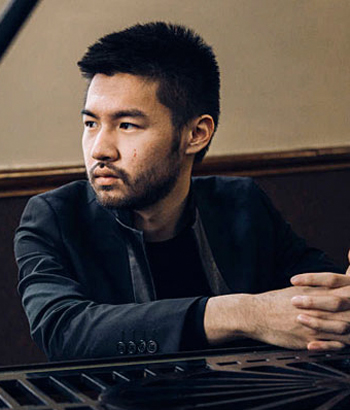by Daniel Hathaway

Tao hung the exhibit in the first half of the concert himself, placing strikingly different pieces by David Lang, Johann Sebastian Bach, Elliott Carter, Julia Wolfe, and Sergei Rachmaninoff side by side on a virtual wall, allowing them to talk amongst themselves.
In an interview with this publication, Conrad Tao said, “I shape my playlists by putting pieces next to each other that work together, but in surprising ways. What I love about juxtaposition is that the possibility of friction is embedded inside it. For me friction is potentially more generative than some sort of easy fusion.” Describing his selection of works to the audience at E.J. Thomas Hall in Akron on Tuesday evening, he noted, “It’s painfully eclectic. I take full responsibility.”
With the help of his incisive intellect and total command of the keyboard, Tao made that gallery tour a compelling if sometimes mystifying experience. At the entrance and exit were two of Lang’s Eight Memory Pieces, “cage” and “wed,” the first an homage to John Cage with a repeating, eight-figure rhythm, the second an essay in polyrhythmic counterpoint. (The other six pieces have such titles as “spartan arcs,” “diet coke,” and “wiggle.”)
Tao gave Bach’s Toccata in f-sharp a dramatically rhetorical performance, contrasting fantastical passages with playful fugues, then leapt directly into Elliott Carter’s Two Thoughts About the Piano.
That composer’s musings are usually complex and knotty, and “Intermittences” and “Caténaires,” written when he was 99, are no exception. The first, dedicated to Peter Serkin, is heavy on dissonance and contrasts. The second, dedicated to Pierre-Laurent Aimard, is in the form of a chain, described by Carter as “a one-line piece with no chords.” Before Tao played it — with astonishing fluency — he characterized it as “Thelonious Monk run amok.”
After the brief and moody respite of Bang On A Can composer Julia Wolfe’s Earring, featuring an insistent high note over lyrical left-hand chords, Tao moved on to a longer work, Sergei Rachmaninoff’s Étude-Tableau in a, Op. 39, No. 2. Painting another kind of picture, Tao gave this brooding scene, fixated on the Dies irae chant, a darkly stunning performance.
Bounding back onstage after intermission, Tao brought vast kinetic energy as well as his keen structural insights as a composer to his masterful playing of Mussorgsky’s Pictures. This is a suite that goads many pianists into self-indulgent flights of pianism, but Conrad Tao was a model of control and restraint. His brush strokes were vivid but not ostentatious. Humorous scenes sparkled. The hut of Baba Yaga was drawn with bizarre but not horrific colors, and no pounding or ringing hammers besmirched the grandeur of the Great Gate of Kiev. Toward the end of his uncannily flawless performance, Tao prominently missed a single left hand octave, as if to prove he was human after all.
After being called back several times, Conrad Tao noted that this had been a “stressful” program, but that he would give the crowd a little something extra. That turned out to be the last movement of Prokofiev’s seventh sonata, a lengthy, fierce toccata that only a 21-year-old would think of dashing off at that point. It was spectacular.
Published on ClevelandClassical.com November 24, 2015.
Click here for a printable copy of this article



